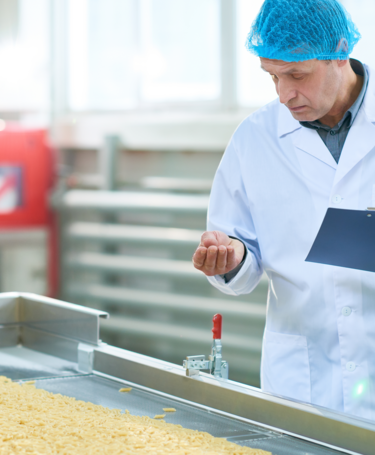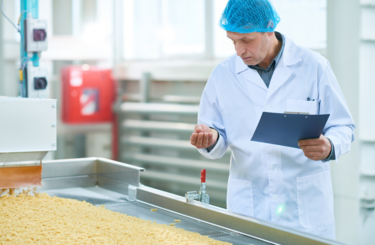
Preventing food fraud

Both the EU and UN describe the current climate as a global food crisis and warn of ‘serious risk’. It is imperative, therefore, that we maintain vigilance to prevent food fraud, says Forbes Fyfe, Agriculture Supply Chain Technical Account Manager at global assurance specialist LRQA.
With stark warnings of a global food crisis, the opportunity for food fraud in the supply chain is ever-increasing. In simple terms, food fraud is the substitution or adulteration of a product with materials that should not be in it. Fundamentally, you are not getting what you would have expected. That could be anything from a straightforward replacement of a product, or a major incident such as the horsemeat scandal of 2013.
One of the realities of food fraud is that it is an economic crime, meaning ultimately someone gains financially; they substitute or downgrade a product and sell it a premium price.
For many organisations, it is something that has been just below their radar; I don’t think people realise how big of an issue it is, because it is hard to detect if you are trying to identify it at the point of receipt of goods.
There is a perception that food fraud is a victimless crime because it is unlikely to cause death, but there is an economic cost in the supply chain and there is risk of a health issue. As a worse-case scenario, if you don’t know what has been substituted and people are consulting a product label because they are concerned about allergens, suddenly it can become a bigger problem. Nut allergies are a major concern now, so if an amount of nut-based oil is substituted into what is labelled as nut-free extra virgin olive oil, there is the potential for a serious health risk or even death.
Complicated supply chains
Food fraud is a global issue but was much less of a concern before the 1980s, when, largely, supply chains were much shorter. Also, we didn’t know nearly as much about food safety then as we do now. The big explosion in food safety kicked off in the late 1980s/early 1990s, with bovine spongiform encephalopathy (BSE) – so-called ‘mad cow disease’. That made us all much more aware of the relationship between sourcing and products, and the wider social health and public safety issue.
We have also seen a significant population increase, as well as the global economy has been growing. In crude terms, as people’s wealth grows, their calorie intake rises. They eat more – and nicer – food, and that has increased pressure on the supply chain. This means that the supply chain has become much more diverse and, as it gets longer, it becomes more complicated.
There is an imbalance in the supply chain; there just isn’t the capacity to produce food at the quantities and levels to meet global demand. When there is pressure on the market, it is inevitable that people will seek to capitalise on that.
There is a supplier hierarchy, with tier one suppliers the first people who are contacted in the supply chain. By and large, you can be pretty confident that they are applying systems and management controls to ensure that what they give to you is safe.
Once we get down to tier two and tier three suppliers, at this point you could be looking at sourcing from anywhere in the context of a global supply chain. You build more linkages into the process and you are a little bit more distant from where the product will eventually end up. That is where, inevitably, the degree of risk becomes higher. As in any sector, you get into the realms of people who don’t necessarily have the same degree of expertise and knowledge, so there is a risk window there.
Unfortunately, you also have people out there who may take the view that they are an awfully long way from the final market of the goods that they are providing and think ‘well, there is a bit of room to cut a few corners.’ That is where, from a food safety perspective, we really need to be focusing.
Preventing food fraud
Prevention is better than cure; so what can you do to prevent it in the first place? More focus on supplier audits in some way, shape or form is one answer and also initiatives such as a project that LRQA is conducting into the use of digital technologies like blockchain to give more traceability in the supply chain.
Things to consider, in the first instance, is whether the supplier is a member of a recognised assurance scheme. That gives a baseline level of confidence. Then check what products are coming from a supplier, where they are coming from and what the potential risks are of sourcing those products – both the intrinsic risks and the extrinsic factors, such as reputational damage. You can control an awful lot of things, but reputational damage is the one thing where you have no idea where it could lead.
Following a risk assessment, if there is a product or supplier that is potentially higher risk, it could pay to build in a more thorough supplier audit process. The product you ordered should be delivered to a specification and quality standard that you asked for in the first place.
How can digital technologies be used to make sure that a product sourced in good faith remains in that condition through the transit process?
Smart tags could be used to quantify how much of a commodity was produced and where it came from, staying with the shipment as it goes through the supply chain. Then, when it comes to a stock reconciliation, it can be confirmed that, for example, the 100 units of organically grown soya beans that you have bought has actually been received. It would confirm that someone hadn’t ‘borrowed’ a bit and substituted it with genetically modified soya – a change you wouldn’t necessarily notice.
Specific incidents, such as war and climate change, produce their own challenges, but we live in a world now where there is going to be pressure on supply just because demand is increasing. At a fundamental level, there is an imbalance in the supply chain; there just isn’t the capacity to produce food at the quantities and levels to meet global demand. When there is pressure on the market, it is inevitable that people will seek to capitalise on that.
You cannot test all products; it is just not viable. But if we can get better control at source with tier 2 and tier 3 suppliers, and greater control and traceability throughout the supply chain, it is possible to get to a place where consumers can continue to buy with confidence.
Food in the news
Find out how quality control failings resulted in a salmonella outbreak.